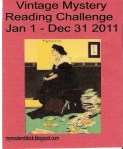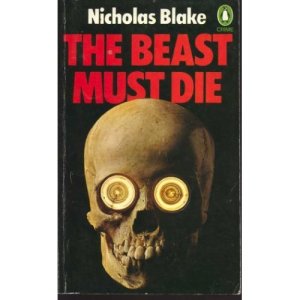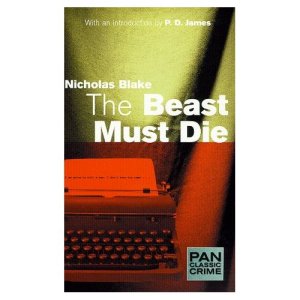 Over at My Reader’s Block Bev has started (and in fact already completed!) a year-long challenge for 2011 – to read a pre-determined number of classic detective stories of a pre-1960 vintage. There are several challenge levels to commit to and one can of course change as it progresses – I will attempt to read 16+ eligible books before the year is out. So, 1 down and 15 to go with a classic pre-war mystery: The Beast Must Die by Nicholas Blake, which begins:
Over at My Reader’s Block Bev has started (and in fact already completed!) a year-long challenge for 2011 – to read a pre-determined number of classic detective stories of a pre-1960 vintage. There are several challenge levels to commit to and one can of course change as it progresses – I will attempt to read 16+ eligible books before the year is out. So, 1 down and 15 to go with a classic pre-war mystery: The Beast Must Die by Nicholas Blake, which begins:
“I am going to kill a man. I don’t know his name, I don’t know where he lives, I have no idea what he looks like. But I am going to find him and kill him … “
So opens this Nicholas Blake novel which is regarded by many to be the author’s finest work and which certainly must rank as his most distinctive. It tells the sad story of mystery novelist Frank Cairnes who, following the death of his son in an unsolved hit-and-run accident, vows to track down the driver of the car and exact revenge.
 The first part of the book, approximately 40% of its length, is taken up with entries from Frank’s diary spread over a period of two months as he confides all his unspoken range, anger and guilt over the death of his young boy, with whom he was particularly close having brought him up almost single-handed with his housekeeper after the death in child-birth of his wife. It is unusually sensitive and well written for a crime novel of this vintage and is undeniably the most significant aspect of the book. Blake himself was well aware that some mystery fans might balk at this extended interior monologue and uses Frank as an alter ego to comment on this at one point, writing:
The first part of the book, approximately 40% of its length, is taken up with entries from Frank’s diary spread over a period of two months as he confides all his unspoken range, anger and guilt over the death of his young boy, with whom he was particularly close having brought him up almost single-handed with his housekeeper after the death in child-birth of his wife. It is unusually sensitive and well written for a crime novel of this vintage and is undeniably the most significant aspect of the book. Blake himself was well aware that some mystery fans might balk at this extended interior monologue and uses Frank as an alter ego to comment on this at one point, writing:
“I am unable to convince myself that detective fiction is a serious branch of literature”.
Blake was, of course, the pseudonym of the poet Cecil Day-Lewis (father of actor Daniel Day-Lewis) and although he initially took to crime writing just as a way to pay the bills, quickly he would become a great supporter of the genre in general. Although he critiques the genre here, he always plays fair with proper clues, both physical and psychological in the Agatha Christie manner. The diary shows how Frank is, through dogged persistence and sheer luck, able to track down the driver – the utterly odious and contemptible George Rattery, quite one of the most repellent characters one could hope to find in the genre. He is married to the sister of young movie starlet Lena Lawson who was in the car on the day of the accident, and who initially comes across as a complete airhead, prone to gushing non sequiturs and making appalling anti-semitic statements like ‘We could do with a of Hitler here’.
Frank, now sporting a beard and using his pen-name ‘Felix Lane’, starts a desperate course of action and dedicates himself to seeking revenge – he cold-bloodedly starts an affair with Lena so as to find a way into the Rattery home, which is ruled with an iron rod by George’s monstrous mother. She crushes the spirit of George’s son Phil and Lena’s sister Violet (who proves to be a real ‘shrinking violet’) with antiquated notions of Victorian propriety. Although Frank becomes quickly attached to the young Phil, who is close to the age of his dead son, he none the less sets about creating a full proof plan to kill George and get away with it. The diary ends just as Frank/Felix is about to set out on a dinghy on a trip during which he plans to kill George.
 The book then shifts to the third person as the diary’s plan goes awry and Frank and Lena have to leave the Rattery home. But when later on George does die, Frank’s secret identity is exposed and he calls on sleuth Nigel Strangways to save him from the hangman. This begins the third section of the book and is the most conventional part of the story, in which a subtle murder plan is eventually uncovered as are a variety of subplots and red herrings as it predictably emerges that nearly everyone involved had a good reason to hate George.
The book then shifts to the third person as the diary’s plan goes awry and Frank and Lena have to leave the Rattery home. But when later on George does die, Frank’s secret identity is exposed and he calls on sleuth Nigel Strangways to save him from the hangman. This begins the third section of the book and is the most conventional part of the story, in which a subtle murder plan is eventually uncovered as are a variety of subplots and red herrings as it predictably emerges that nearly everyone involved had a good reason to hate George.
The conclusion to the story is clever and logical and if not a complete surprise is however extremely satisfying. The integration of more mature elements into the story, with a fairly realistic handling of characters and motivation, can jar with the basic mechanics of what is outwardly a fairly standard country-house mystery – indeed, one could easily excise the diary and still have a medium-length detective story that would be no worse than so many others published in the 1930s – but it would lose not only its unique flavour but would clearly deflate the noble intention to bring the literary novel and the detective story together, which it does with considerably success even if it can’t quite overcome the breach in style from around the halfway mark once the murder has been committed.
This is a fine detective novel, one that succeeds well in its modest aspiration to broaden the horizons of the genre.
![]()
***** (4 fedora tips out of 5)


Hi
Reviewed this recently. Somehow to me, it failed to live up to its premise.
Hello there – shame you didn’t like it more. I thought it used its basic premise very cleverly, though inevitably time has ensured that the surprise element has prhaps made it seem less surprising.
Claude Chabrol’s brilliant 1969 film “Que la bete meure” is based on this novel. I would also recommend Chabrol’s version of Ruth Rendell’s “A Judgement in Stone”.Filmed as “La Ceremonie” in 1995.
Thanks for that – they are both terrific movies, I quite agree. Chabrol could be a bit hit and miss in his adaptations of classic crime fiction – I quite liked Merci pour le chocolat, his version of Charlotte Armstrong’s ‘The Chocolate Cobweb’ but the adaptation of Ellery Queen’s ’10 Day’s Wonder’ was pretty disastrous in its excess of portents and symbols.
Yes, the book worked very well for me too. That first section really draws you in and I was riveted right to the end.
It’s really strong hook after all and I think a very powerful one – Blake / Day Lewis deserves a lot of credit for hmanising the fomral detective story. Having said that, and knowing that there will be puzzle to be solved, does both alter how you approach it and what to look for in the second half – a major performance though, I quite agree.
Pingback: A Murder is Announced, by Agatha Christie (1950): A Bayardian exploration | Noah's Archives
Pingback: The Beast Must Die (1938) by Nicholas Blake – crossexaminingcrime
Pingback: The Beast Must Die by Nicholas Blake – Mysteries Ahoy!